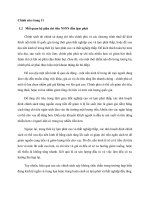Chương 17 Thuế và chi tiêu chính phủ pptx
Bạn đang xem bản rút gọn của tài liệu. Xem và tải ngay bản đầy đủ của tài liệu tại đây (98.14 KB, 11 trang )
Chapter 17
Taxes and government spending
David Begg, Stanley Fischer and Rudiger Dornbusch, Economics,
6th Edition, McGraw-Hill, 2000
Power Point presentation by Peter Smith
17.2
Government spending in the UK
0
10
20
30
40
50
% of
GDP
UK
Government spending
1956 1976 1999
The scale of
government
spending has
changed over the
past four decades.
It is now running at
just under 40%.
17.3
Government spending
EQUITY
–
a progressive tax and transfer system
redistributes income from rich to poor
EFFICIENCY
–
correction of market failure may
improve resource allocation
We may justify government spending on two grounds:
17.4
Private and public goods
A private good
–
if consumed by one person, cannot be
consumed by another person.
e.g. dental treatment
A public good
–
even if consumed by one person, can
still be consumed by other people.
e.g. street lighting
There are strong externalities associated with public goods,
so government intervention may be justified to ensure
appropriate provision.
17.5
Merit goods and bads
Merit goods (bads)
–
goods (bads) that society thinks
everyone ought to have (ought not to
have) regardless of whether they are
wanted by each individual.
e.g. Education, health services, cigarettes
–
The government may spend money on
compulsory education or compulsory
vaccination because it recognizes that
otherwise individuals act in a way they will
subsequently regret.
17.6
Varieties of taxes
Direct taxes
–
taxes on earnings from labour, rents,
dividends and interest.
e.g. income tax, corporation tax
Indirect taxes
–
taxes levied on expenditures on goods
and services
e.g. VAT, duty on alcohol
Wealth taxes
–
capital transfer tax, tax on property
17.7
Employers pay the green
area, and workers the blue.
A tax on wages
Hours worked
W
a
g
e
L
W
DD
SS
With no tax, the labour
market is in equilibrium
at wage W, hours L.
L'
SS'
W'
W''
With a tax, labour supply
is effectively at SS',
workers receive W'',
but firms pay W', the
difference being the tax.
The red area is a welfare
loss for society.
17.8
The incidence of a tax
Who pays a tax depends upon the
elasticity of demand and supply for
the product.
This also affects the size of
distortion caused by the imposition
of a tax.
17.9
A tax to offset an externality
Quantity
P
r
i
c
e
DD
SS
Given private demand DD
and supply SS, free market
equilibrium is at Q.
Q
A tax of E*F enables
this optimum to be
reached.
F
SS'
DD'
E*
Q*
But if there is a negative
consumption externality
(e.g. from smoking), the
social optimum is at Q*.
17.10
The Laffer curve
shows how much tax revenue is raised at each
possible tax rate. Beyond t*, higher tax rates reduce
revenue because of disincentive effects.
t*
100%
Tax rate
T
a
x
r
e
v
e
n
u
e
17.11
Economic sovereignty
Increasing integration of countries in
the world economy reduces the
economic sovereignty of individual
nations.
Co-operation is needed to cope with
transnational externalities.









